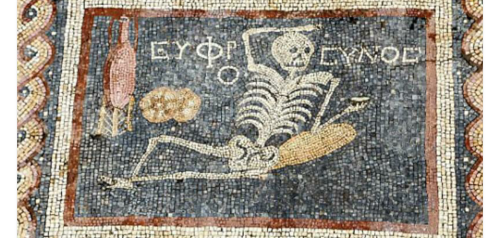In-pursuit-of-knowledge-blog - Everything Is Interesting!

More Posts from In-pursuit-of-knowledge-blog and Others


Hide the cheese and crackers guys, this raccoon skull is W H I T E!
Seems like heating peroxide to a comfortably warm temperature makes it work twice as fast. This skull now looks like a plastic replica rather than a real skull. Its also 100% complete! My first complete raccoon skull. No cracks, no missing teeth, nothing. Just absolutely perfect.
Cultures are defensive constructions against chaos, designed to reduce the impact of randomness on experience.
Mihaly Csikszentmihalyi (via inthenoosphere)
9 Ocean Facts You Likely Don’t Know, but Should
Earth is a place dominated by water, mainly oceans. It’s also a place our researchers study to understand life. Trillions of gallons of water flow freely across the surface of our blue-green planet. Ocean’s vibrant ecosystems impact our lives in many ways.
In celebration of World Oceans Day, here are a few things you might not know about these complex waterways.
1. Why is the ocean blue?

The way light is absorbed and scattered throughout the ocean determines which colors it takes on. Red, orange, yellow,and green light are absorbed quickly beneath the surface, leaving blue light to be scattered and reflected back. This causes us to see various blue and violet hues.
2. Want a good fishing spot?

Follow the phytoplankton! These small plant-like organisms are the beginning of the food web for most of the ocean. As phytoplankton grow and multiply, they are eaten by zooplankton, small fish and other animals. Larger animals then eat the smaller ones. The fishing industry identifies good spots by using ocean color images to locate areas rich in phytoplankton. Phytoplankton, as revealed by ocean color, frequently show scientists where ocean currents provide nutrients for plant growth.
3. The ocean is many colors.

When we look at the ocean from space, we see many different shades of blue. Using instruments that are more sensitive than the human eye, we can measure carefully the fantastic array of colors of the ocean. Different colors may reveal the presence and amount of phytoplankton, sediments and dissolved organic matter.
4. The ocean can be a dark place.
About 70 percent of the planet is ocean, with an average depth of more than 12,400 feet. Given that light doesn’t penetrate much deeper than 330 feet below the water’s surface (in the clearest water), most of our planet is in a perpetual state of darkness. Although dark, this part of the ocean still supports many forms of life, some of which are fed by sinking phytoplankton.
5. We study all aspects of ocean life.

Instruments on satellites in space, hundreds of kilometers above us, can measure many things about the sea: surface winds, sea surface temperature, water color, wave height, and height of the ocean surface.
6. In a gallon of average sea water, there is about ½ cup of salt.

The amount of salt varies depending on location. The Atlantic Ocean is saltier than the Pacific Ocean, for instance. Most of the salt in the ocean is the same kind of salt we put on our food: sodium chloride.
7. A single drop of sea water is teeming with life.

It will most likely have millions (yes, millions!) of bacteria and viruses, thousands of phytoplankton cells, and even some fish eggs, baby crabs, and small worms.
8. Where does Earth store freshwater?

Just 3.5 percent of Earth’s water is fresh—that is, with few salts in it. You can find Earth’s freshwater in our lakes, rivers, and streams, but don’t forget groundwater and glaciers. Over 68 percent of Earth’s freshwater is locked up in ice and glaciers. And another 30 percent is in groundwater.
9. Phytoplankton are the “lungs of the ocean”.

Just like forests are considered the “lungs of the earth”, phytoplankton is known for providing the same service in the ocean! They consume carbon dioxide, dissolved in the sunlit portion of the ocean, and produce about half of the world’s oxygen.
Want to learn more about how we study the ocean? Follow @NASAEarth on twitter.
Make sure to follow us on Tumblr for your regular dose of space: http://nasa.tumblr.com.
Help Explore Your Own Solar Neighborhood
We’re always making amazing discoveries about the farthest reaches of our universe, but there’s also plenty of unexplored territory much closer to home.

Our “Backyard Worlds: Planet 9” is a citizen science project that asks curious people like you — yes, you there! — to help us spot objects in the area around our own solar system like brown dwarfs. You could even help us figure out if our solar system hosts a mysterious Planet 9!

In 2009, we launched the Wide-field Infrared Survey Explorer (WISE). Infrared radiation is a form of light that humans can’t see, but WISE could. It scans the sky for infrared light, looking for galaxies, stars and asteroids. Later on, scientists started using it to search for near-Earth objects (NEOWISE) like comets and asteroids.

These searches have already turned up so much data that researchers have trouble hunting through all of it. They can’t do it on their own. That’s why we asked everyone to chip in. If you join Backyard Worlds: Planet 9, you’ll learn how to look at noisy images of space and spot previously unidentified objects.
You’ll figure out how to tell the difference between real objects, like planets and stars, and artifacts. Artifacts are blurry blobs of light that got scattered around in WISE’s instruments while it was looking at the sky. These “optical ghosts” sometimes look like real objects.

Why can’t we use computers to do this, you ask? Well, computers are good at lots of things, like crunching numbers. But when it comes to recognizing when something’s a ghostly artifact and when it’s a real object, humans beat software all the time. After some practice, you’ll be able to recognize which objects are real and which aren’t just by watching them move!

One of the things our citizen scientists look for are brown dwarfs, which are balls of gas too big to be planets and too small to be stars. These objects are some of our nearest neighbors, and scientists think there’s probably a bunch of them floating around nearby, we just haven’t been able to find all of them yet.
But since Backyard Worlds launched on February 15, 2016, our volunteers have spotted 432 candidate brown dwarfs. We’ve been able to follow up 20 of these with ground-based telescopes so far, and 17 have turned out to be real!

Image Credit: Ryan Trainor, Franklin and Marshall College
How do we know for sure that we’ve spotted actual, bona fide, authentic brown dwarfs? Well, like with any discovery in science, we followed up with more observation. Our team gets time on ground-based observatories like the InfraRed Telescope Facility in Hawaii, the Magellan Telescope in Chile (pictured above) and the Apache Point Observatory in New Mexico and takes a closer look at our candidates. And sure enough, our participants found 17 brown dwarfs!

But we’re not done! There’s still lots of data to go through. In particular, we want your help looking for a potential addition to our solar system’s census: Planet 9. Some scientists think it’s circling somewhere out there past Pluto. No one has seen anything yet, but it could be you! Or drop by and contribute to our other citizen science projects like Disk Detective.
Congratulations to the citizen scientists who spotted these 17 brown dwarfs: Dan Caselden, Rosa Castro, Guillaume Colin, Sam Deen, Bob Fletcher, Sam Goodman, Les Hamlet, Khasan Mokaev, Jörg Schümann and Tamara Stajic.
Make sure to follow us on Tumblr for your regular dose of space: http://nasa.tumblr.com.
Solar System: 10 Things to Know
Movie Night
Summer break is just around the corner. Hang a sheet from the clothesline in the backyard and fire up the projector for a NASA movie night.
1. Mars in a Minute

Back in the day, movies started with a cartoon. Learn the secrets of the Red Planet in these animated 60 second chunks.
2. Crash of the Titans

Watch two galaxies collide billions of years from now in this high-definition visualization.
3. Tour the Moon in 4K

Wait for the dark of the waning Moon next weekend to take in this 4K tour of our constant celestial companion.
4. Seven Years of the Sun

Watch graceful dances in the Sun’s atmosphere in this series of videos created by our 24/7 Sun-sentinel, the Solar Dynamic Observatory (SDO).
5. Light ‘Em Up

Crank up the volume and learn about NASA science for this short video about some of our science missions, featuring a track by Fall Out Boy.
6. Bennu’s Journey

Follow an asteroid from its humble origins to its upcoming encounter with our spacecraft in this stunning visualization.
7. Lunar Landing Practice
Join Apollo mission pilots as they fly—and even crash—during daring practice runs for landing on the Moon.
8. Earthrise

Join the crew of Apollo 8 as they become the first human beings to see the Earth rise over the surface of the Moon.
9. Musical Descent to Titan

Watch a musical, whimsical recreation of the 2005 Huygens probe descent to Titan, Saturn’s giant moon.
10. More Movies

Our Goddard Scientific Visualization Studio provides a steady stream of fresh videos for your summer viewing pleasure. Come back often and enjoy.
Read the full version of this article on the web HERE.
Make sure to follow us on Tumblr for your regular dose of space: http://nasa.tumblr.com.

Here’s an artsy peak at some giant clams behind the scenes! Their luminous colors and patterns are thanks to tiny, helpful algae that live inside the clams’ tissues.
Thank you to staffer Kat for the photo!

-
 keepsie reblogged this · 1 month ago
keepsie reblogged this · 1 month ago -
 7-a-m liked this · 3 months ago
7-a-m liked this · 3 months ago -
 apantomancja liked this · 4 months ago
apantomancja liked this · 4 months ago -
 bleunote9 reblogged this · 2 years ago
bleunote9 reblogged this · 2 years ago -
 scramblercj8 liked this · 2 years ago
scramblercj8 liked this · 2 years ago -
 opspro2005 liked this · 2 years ago
opspro2005 liked this · 2 years ago -
 ao-fc reblogged this · 2 years ago
ao-fc reblogged this · 2 years ago -
 ao-fc liked this · 2 years ago
ao-fc liked this · 2 years ago -
 wedemboiz-bottomtext liked this · 2 years ago
wedemboiz-bottomtext liked this · 2 years ago -
 orlondo-303 liked this · 2 years ago
orlondo-303 liked this · 2 years ago -
 cealdicy liked this · 2 years ago
cealdicy liked this · 2 years ago -
 lel0le liked this · 2 years ago
lel0le liked this · 2 years ago -
 stargrrrl liked this · 2 years ago
stargrrrl liked this · 2 years ago -
 missccellaneous reblogged this · 2 years ago
missccellaneous reblogged this · 2 years ago -
 saltyspillway liked this · 3 years ago
saltyspillway liked this · 3 years ago -
 lulla-bee liked this · 3 years ago
lulla-bee liked this · 3 years ago -
 inmortalidaddelcangrejo liked this · 3 years ago
inmortalidaddelcangrejo liked this · 3 years ago -
 p3trichor11 liked this · 3 years ago
p3trichor11 liked this · 3 years ago -
 le-avist0 liked this · 3 years ago
le-avist0 liked this · 3 years ago -
 autocorreckt liked this · 3 years ago
autocorreckt liked this · 3 years ago -
 negatiivinenkasapaskaa reblogged this · 3 years ago
negatiivinenkasapaskaa reblogged this · 3 years ago -
 negatiivinenkasapaskaa liked this · 3 years ago
negatiivinenkasapaskaa liked this · 3 years ago -
 burnt-tomato-slush liked this · 3 years ago
burnt-tomato-slush liked this · 3 years ago -
 luminoussphereofplasma reblogged this · 3 years ago
luminoussphereofplasma reblogged this · 3 years ago -
 lelunacy reblogged this · 4 years ago
lelunacy reblogged this · 4 years ago -
 ifang2 reblogged this · 4 years ago
ifang2 reblogged this · 4 years ago -
 lookatthisbro reblogged this · 4 years ago
lookatthisbro reblogged this · 4 years ago -
 swordsgoblin reblogged this · 4 years ago
swordsgoblin reblogged this · 4 years ago -
 katerwaiter97 liked this · 4 years ago
katerwaiter97 liked this · 4 years ago -
 choenpam reblogged this · 4 years ago
choenpam reblogged this · 4 years ago -
 teethcult liked this · 4 years ago
teethcult liked this · 4 years ago -
 1arkspur liked this · 4 years ago
1arkspur liked this · 4 years ago -
 water4otter liked this · 5 years ago
water4otter liked this · 5 years ago -
 saferintheforestt liked this · 5 years ago
saferintheforestt liked this · 5 years ago -
 sharktino reblogged this · 5 years ago
sharktino reblogged this · 5 years ago -
 anekochan reblogged this · 5 years ago
anekochan reblogged this · 5 years ago -
 anekochan liked this · 5 years ago
anekochan liked this · 5 years ago
Once I was made of stardust. Now I am made of flesh and I can experience our agreed-upon reality and said reality is exciting and beautiful and terrifying and full of interesting things to compile on a blog! / 27 / ENTP / they-them / Divination Wizard / B.E.y.O.N.D. department of Research and Development / scientist / science enthusiast / [fantasyd20 character]
162 posts




